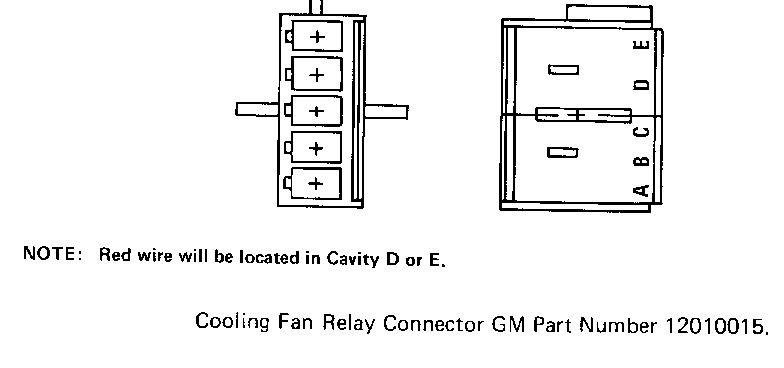COOLING FAN INOPERATIVE DAMAGED,BENT,DEFORMED TERMINAL

VEHICLES AFFECTED: 1985 'A' Car With 2.5L L4 Engine VIN Code (R) 1985 'J' Car With 1.8L L4 Engine VIN Code (O) ---------------------------------------------
Some of the above vehicles may experience an inoperative or an intermittent operating cooling fan.
This condition may be caused by a damaged (bent or deformed) terminal on the red No. 2 circuit wire in the cooling fan relay connector. This red No. 2 circuit wire is located in either cavity D or E of the connector, depending on the make of vehicle and the harness and relay that is used.
To repair this condition the following procedure should be followed:
1. Disconnect negative battery cable.
2. Disconnect cooling fan relay.
3. Remove the red No. 2 circuit wire terminal from cavity D or E of the connector. Inspect the terminal for damage in the area shown on the illustration.
4. If terminal is not damaged, insert terminal back into the connector and reconnect the relay.
5. If terminal is damaged in the area shown, remove and replace with a new terminal, making sure to crimp and solder for a good connection.
6. Insert terminal back into connector and reconnect the relay.
7. Connect the negative battery cable.
NOTICE: If the cooling fan is still inoperative after this procedure is performed, follow Service Manual Diagnostics for analysis of total cooling fan system.
The breakpoint VIN's for vehicles already reworked at the assembly plants are as follows:
Framingham: Chevrolet FG152616 Oldsmobile FD396094
Doraville: Buick FD457235 Oldsmobile FD456161
Leeds: Buick FK473047 Oldsmobile FK345450
Lordstown: Pontiac F7594797
Oklahoma: Chevrolet F6269312 Buick F6504299
Oshawa No. 1: Pontiac F9739378 Oldsmobile F9320731
Oshawa No. 2: Chevrolet F1196537
Tarrytown: Pontiac FT225130 Buick FT450056


General Motors bulletins are intended for use by professional technicians, not a "do-it-yourselfer". They are written to inform those technicians of conditions that may occur on some vehicles, or to provide information that could assist in the proper service of a vehicle. Properly trained technicians have the equipment, tools, safety instructions and know-how to do a job properly and safely. If a condition is described, do not assume that the bulletin applies to your vehicle, or that your vehicle will have that condition. See a General Motors dealer servicing your brand of General Motors vehicle for information on whether your vehicle may benefit from the information.
